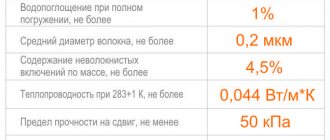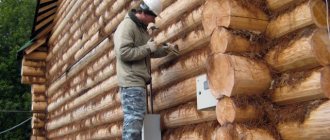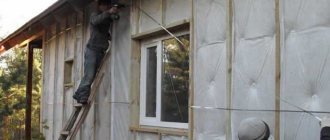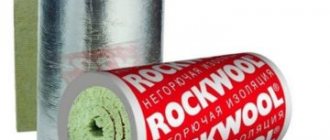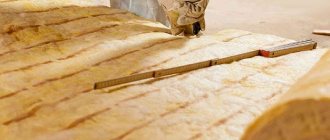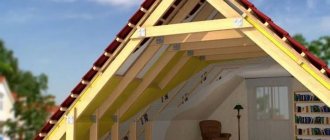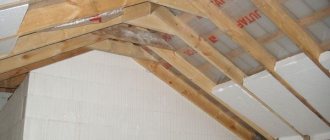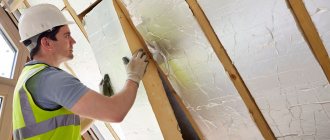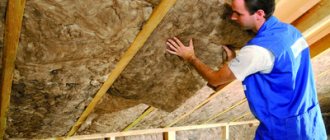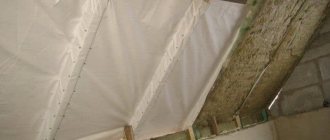For comfortable living in a house, high-quality, durable and reliable thermal insulation of the roof is necessary - regardless of its structural features and external conditions. Let's consider what types of material are used to insulate a roof from the inside, what requirements are placed on it when choosing it, what types of roofs exist, what are the features of their thermal insulation, and also what stages the technology of laying the material consists of.
Roof insulation from the inside Source build-blog.ru
Requirements for roof insulation
When deciding how to insulate the roof of a house from the inside so that there is no condensation, it is necessary to proceed from the operating conditions of the thermal insulation material. Insulation in the roof is subject to the following number of negative influences:
- Temperature changes.
- High humidity.
- Atmospheric precipitation.
- Weathering.
- Solar radiation.
- Pressure from building and finishing materials and deformation from fasteners.
- A couple from the premises.
Option for installing roof insulation Source zagorodnye-doma.ru
In addition, there is always the possibility of fire - both from external (for example, from lightning or a fire in neighboring buildings) and internal factors (malfunction of electrical wiring, heating system, kitchen appliances, etc. ). Therefore, when choosing a thermal insulation material for a roof, the following series of requirements are imposed:
- Minimum thermal conductivity.
The main property of a roofing thermal insulation layer is, first of all, the preservation of heat in the house. Therefore, the less ability it has to conduct heat through itself, the more comfortable it will be in the house, and the lower the heating costs.
- High sound insulation parameters.
When insulating an attic, it is important to give the roof not only heat-insulating, but also sound-proofing properties. Since the room does not have full walls, any rustling inside or outside will be perfectly audible.
- Fire resistance.
The roofing part of the house is least supervised. Any slightest fire hazard can lead to a fire. Therefore, thermal insulation must not only be non-flammable, but also prevent the possible spread of fire.
Installation of fire-resistant insulation Source skruna.ru
- Preservation of properties when moistened.
No roofing system is immune to leaks. As a rule, when wet, insulation immediately loses its properties. To avoid this, it is better to choose a material that is resistant to dampness and direct contact with water.
- Structure stability.
Elastic, durable, hard-to-tear material is easy to install and lasts a long time, and is also less subject to deformation.
- Optimal weight.
Weighting the roof can lead to disruption of the stability of the entire building and destruction of the foundation, especially if the project initially does not have an additional safety margin. Therefore, the heat-insulating material must have minimal weight.
Note! The lower the density of the heat-insulating material, the higher its heat-saving properties. However, excessive porosity, which increases this indicator, can significantly increase the ability to transfer heat and worsen its insulating qualities.
Low density insulation Source dekoriko.ru
We insulate the roof with mineral wool
The operation scheme is described above, but some nuances should be considered in more detail. Mineral wool is perfect for insulating a roof with your own hands. The choice of mineral wool is dictated by its availability and low price with excellent thermal insulation qualities. Of all the varieties, preference is given to Ecobasalt , as the most convenient and effective to use.
IMPORTANT!
If the thickness of the slabs does not correspond to the height of the rafters, then laying is done in several layers so that the joint of one layer overlaps the solid part of the other for greater density and tightness. A sheet of mineral wool is inserted by surprise and secured with fishing line. You can read more about roof insulation with mineral wool at the link.
Mineral wool as an insulation material is notable for the fact that it does not burn . Unlike other types of insulation, it is made from metallurgical waste or from rocks (basalt). Therefore, when using it, the residents of the house are insured against fire and the release of corrosive gases.
Types of thermal insulation materials
Modern construction technologies offer several options for how to insulate an attic using thermal insulation materials. The procedure is carried out using primarily the following types of insulation:
- Expanded polystyrene.
- Mineral wool.
- Penoplex.
- Polyurethane foam.
- Ecowool.
- Penoizol.
- Expanded clay.
- Sawdust.
Let us consider in detail their main features, pros and cons, as well as the nuances of insulation with their help.
Expanded polystyrene
Thermal insulating material of a cellular structure based on the polymer compound of expanded polystyrene, or polystyrene foam, is one of the most inexpensive and popular for insulating various structures. Available for sale in the form of rectangular slabs, differing in the following technical characteristics:
- Thickness.
- Densities.
- Thermal conductivity coefficient.
Roof insulated with foam plastic Source orchardo.ru
The specific type of material is selected based on the conditions of use. For example, when installing on a vertical surface or roof at a large angle without load, an option with a minimum density is allowed. On the contrary, when laying it in a horizontal plane, the most dense insulation of this type will be required.
Advantages of the material:
- Minimum thermal conductivity coefficient.
- Low specific gravity.
- Low cost.
- Easy to process.
- Biological resistance.
Main disadvantages:
- Inflammable quickly and easily, there is a high risk of fire.
- Emission of toxic smoke when burning.
- It is able to become saturated with moisture, as a result of which it loses some of its heat-insulating properties.
Despite all its disadvantages, polystyrene foam, due to its low cost, is a popular option for thermal insulation material for roofs, provided that it is fully protected from fire and moisture.
Thermal insulation of the attic with polystyrene foam Source stroisam2.ru
See also: Catalog of companies that specialize in home insulation
Mineral wool
Laying mineral or stone wool is another common way to insulate an attic for winter living. The material is made on the basis of rocks and has a number of advantages:
- It has a structure similar to glass wool, but is more dense and elastic. In addition, it can be taken by hand without negative consequences, which greatly simplifies the installation procedure.
- It has a convenient shape - in the form of slabs or rolls - depending on the density.
- With special treatment, the material acquires a water-repellent surface.
- Does not contain harmful components.
- Not only does it not burn itself, but it is also able to protect the surface of a combustible material from ignition.
- It allows steam to pass through well, so that healthy microclimatic conditions are always maintained in the room, and the rafter system gets rid of the accumulation of dampness.
- Has an optimal price.
At the same time, stone wool has a couple of significant drawbacks - a rather high thermal conductivity coefficient and deformation and loss of properties when wet. Therefore, the material must be installed in a thicker layer and reliable moisture protection must be provided.
Roof insulation from the inside with mineral wool Source ytimg.com
Penoplex
Extruded polystyrene foam or simply penoplex differs from conventional polystyrene foam both visually and in terms of performance characteristics. The first sign is that it always has a bright color. The structure is more uniform and not grainy.
Clear advantages of penoplex:
- Long service life.
- Strength.
- Low thermal conductivity.
- Moisture-repellent ability.
- Resistance to fire - does not support combustion; when the flame spreads, it immediately goes out.
At the same time, in addition to its high cost, penoplex has negative manifestations characteristic of expanded polystyrene - impermeability to steam and the formation of toxic volatile substances under strong heating. Otherwise, the material is quite reliable and safe. They are allowed to insulate roofs at fire-hazardous facilities, for example, in a bathhouse.
Insulating the attic with penoplex Source oboiman.ru
Polyurethane foam
The only way to insulate an attic roof from the inside in order to seal all the cavities of the most geometrically difficult structure is to use liquid-foam spraying of polyurethane foam. Polyurethane foam is its analogue for small-volume work. When insulating attics, roofs and attics, special industrial installations are used. In this case, the composition is prepared from two ingredients directly at the site of application.
The material instantly sets during installation, hardens and forms a fairly strong, durable thermal insulation layer that is not subject to dampness and temperature changes. Among its main advantages are:
- Unprecedentedly low thermal conductivity, so that the resulting layer retains heat much better than ready-made foam insulation - polystyrene foam and its analogues.
- Continuous sealed surface – thanks to spray application technology.
- High adhesive properties.
- High laying speed.
- There is no need for special fasteners during installation.
- Fire resistance - due to the presence of fire retardant additives in the composition.
Spraying polyurethane foam Source znatoktepla.ru
The technology of applying polyurethane foam is both its advantage and disadvantage. Since spraying requires special equipment. In addition, the master must have experience, otherwise the coating will not have the necessary heat-insulating properties. In addition, it is necessary to work while spraying in a chemical protective suit, a respirator and goggles - at the initial stage of polymerization, the foam releases toxic volatile components.
Selection of tools
If you ask a professional roofer what tools you need to have to insulate the roof, he will probably answer that a knife, a hammer, a clear head and skillful hands. Essentially, this is the case, but there are subtleties and secrets that not everyone wants to divulge.
Roofing tools
The most important detail and, accordingly, the trick is choosing a knife . If you take a regular mounting knife, you will be able to work, but throughout the entire time you will suffer from unevenly cutting off pieces of insulation. Such a construction tool has a blade that is too short and is unable to cut through a thick layer of heat-insulating material. In addition to all this, a standard knife will quickly become dull on polystyrene foam or mineral wool.
If you don’t have a knife, then you can use improvised means for cutting - a hacksaw for wood or a wide kitchen bread cleaver with a lumpy sharpening.
The ideal option would be to purchase a special professional long knife . It is made taking into account the requirements placed on it - made of carbon steel with a length of 35 cm and a comfortable handle made of high-quality plastic.
Professional knife
In addition to a good cutting tool, you will definitely need a hammer, a screwdriver, self-tapping screws of different lengths, a long strong cord, reliable protective clothing, glasses to preserve your vision and a respirator.
It would also be a good idea to listen to the following recommendations:
- the place where thermal insulation materials are to be cut must be well ventilated;
- carefully protect your hands, head area and, especially, the respiratory tract with your eyes - they are most susceptible to damage from flying fibers;
- after work, immediately take a shower, thoroughly washing your hands, face and other areas of the skin;
- before cutting, make sure that the size is correct - the pieces should fit freely between the rafters, without falling out or being squeezed;
- It is advisable to cut mineral wool across the fibers - this minimizes the release of flying particles.
Cutting mineral wool
Insulation of different types of roofs
The shape of the roof of the house can be any - gable, flat, attic, etc. The internal space formed by the roof structure can be used as a living space or storage. The requirements for insulation, as well as the features of its installation technology, are different in one case or another. Based on this, there are the following typical options for roof insulation:
- attic floor;
- non-residential premises;
- insulated attic;
- flat roof.
Let's look at the main features of insulation of each option in more detail.
Insulation of the attic floor Source legkovmeste.ru
Video description
Watch this video on how to properly insulate an attic:
Advice! When choosing a way to properly insulate an attic from the inside with your own hands, you must take into account that the air in a living space is always saturated with moisture. Therefore, the material must be installed so that wooden rafters and sheathing do not accumulate dampness and during further operation are not subject to destruction from biological factors (rot, mold, fungus).
Non-residential premises
The unheated space between the horizontal floor (ceiling) and the roofing system serves as a kind of barrier that prevents heat from escaping from the lower living space. However, in the middle zone and in the northern regions this is clearly not enough. Full insulation is required. In this case, there is no need to insulate the slopes - it is enough to thermally insulate the ceiling itself.
Features of installing a plasterboard ceiling
It is also enough to cover the finished rafter structure with plasterboard, and the gap between the sheets should not exceed 0.1 mm. In addition to the proposed option, finishing the attic ceiling can be done in other ways, for example, for some, traditional painting will be enough.
Drywall, acting as a universal material, allows you to build unusual structures and realize the most fantastic design ideas. Thanks to gypsum plasterboard, interior decoration of the attic can be done using various paints and varnishes, wallpaper of different textures and other things.
Video description
In this video, see an example of how the floor of a cold attic is insulated:
Almost all of the above materials are suitable for this. The only thing you need to pay attention to is fire safety. For example, in houses with stove heating, at the point of contact between the pipe and the ceiling, it is better to use non-flammable insulation - mineral wool or penoplex.
Insulated attic
In a private house there is often a need to have insulated non-residential premises. The space between the roofing system and the ceiling is sometimes the best solution to this problem. In this case, similar methods used for the option with attic insulation are suitable. Both slopes and gables need to be insulated. The only difference is in the choice of materials. For the attic, the requirements are somewhat relaxed - since the premises are non-residential.
Flat roof
Insulating a flat roof from the inside is quite problematic. Basically, this procedure is performed externally. However, if the roof is already erected, there is no choice. In this case, dense slab materials are suitable, allowing them to be fastened from bottom to top using special fasteners. As an option, you can use spray foam insulation.
Stages of insulation technology
The instructions on how to insulate an attic for winter living with your own hands are step by step as follows:
- Selection and calculation of the required insulation.
- Preparation of the material - adjustment to the distance between the rafters, thickness and other physical parameters.
- Laying a waterproofing layer on the sheathing.
- Installation of insulation.
- Laying vapor barrier.
- Fastening the counter-lattice.
- Fastening of finishing materials.
You can perform such a complex procedure yourself, but it is better to entrust it to a professional team.
Recommendation! When taking into account all the nuances of the question of how to insulate an attic from the inside with your own hands, we must not forget about the proper installation of the waterproofing layer. In its absence, the thermal insulation layer will quickly become damp, since condensation always accumulates under the roof. Waterproofing should be located under the roofing material and above the insulation - but not close. A ventilation gap is required.
Errors and recommendations
Visually, errors in roof insulation manifest themselves in the appearance of wet spots on the inner lining , melting snow on certain areas of the slope, or other signs of condensation accumulation. Most often they arise due to violations of the pie laying technology, including:
Excessively tight connection of the insulation to the impermeable waterproofing layer.- Errors in the installation of insulating films and layers (fastening without overlapping or sealing joints, choosing the wrong side, mechanical damage, overhanging or excessive tension, lack of ventilation gaps).
- Wrinkling of insulation when laying from the inside.
- Installation of materials that have accumulated moisture or covering wet surfaces with them, carrying out work under unfavorable conditions.
- Refusal to prepare and process wooden frame elements and sheathing.
Errors in organizing condensate drainage and cake ventilation deserve special mention. Ventilation gaps between layers will not matter if there is no possibility of condensate being discharged outside, an unprotected cornice or insufficient air exchange.
When installing internal insulation, many owners miss this point and leave the overhangs unlined or, conversely, tightly block the eaves or ridge. The last mistake is more common; internal insulation of the roof is often carried out after it has been put into operation, with previously installed and sewn eaves.
Advice. If you doubt your skills, you should discuss the method of draining and weathering condensate with specialists.
Briefly about the main thing
There are several options for how to insulate an attic roof using available insulation materials:
- expanded polystyrene;
- stone wool;
- penoplex;
- polyurethane foam;
- ecowool;
- penoizol;
- expanded clay;
- sawdust.
Each method has its own characteristics, pros, cons and purpose. In addition to the attic insulation method, there are other options for roof insulation - a warm attic, only the ceiling and flat blood.
When choosing an insulating material, it is necessary to take into account thermal conductivity, sound insulation capabilities, toxicity, flammability, density, structural stability and specific gravity. Insulation can be done on your own according to the instructions, but it is better to seek help from professionals.
